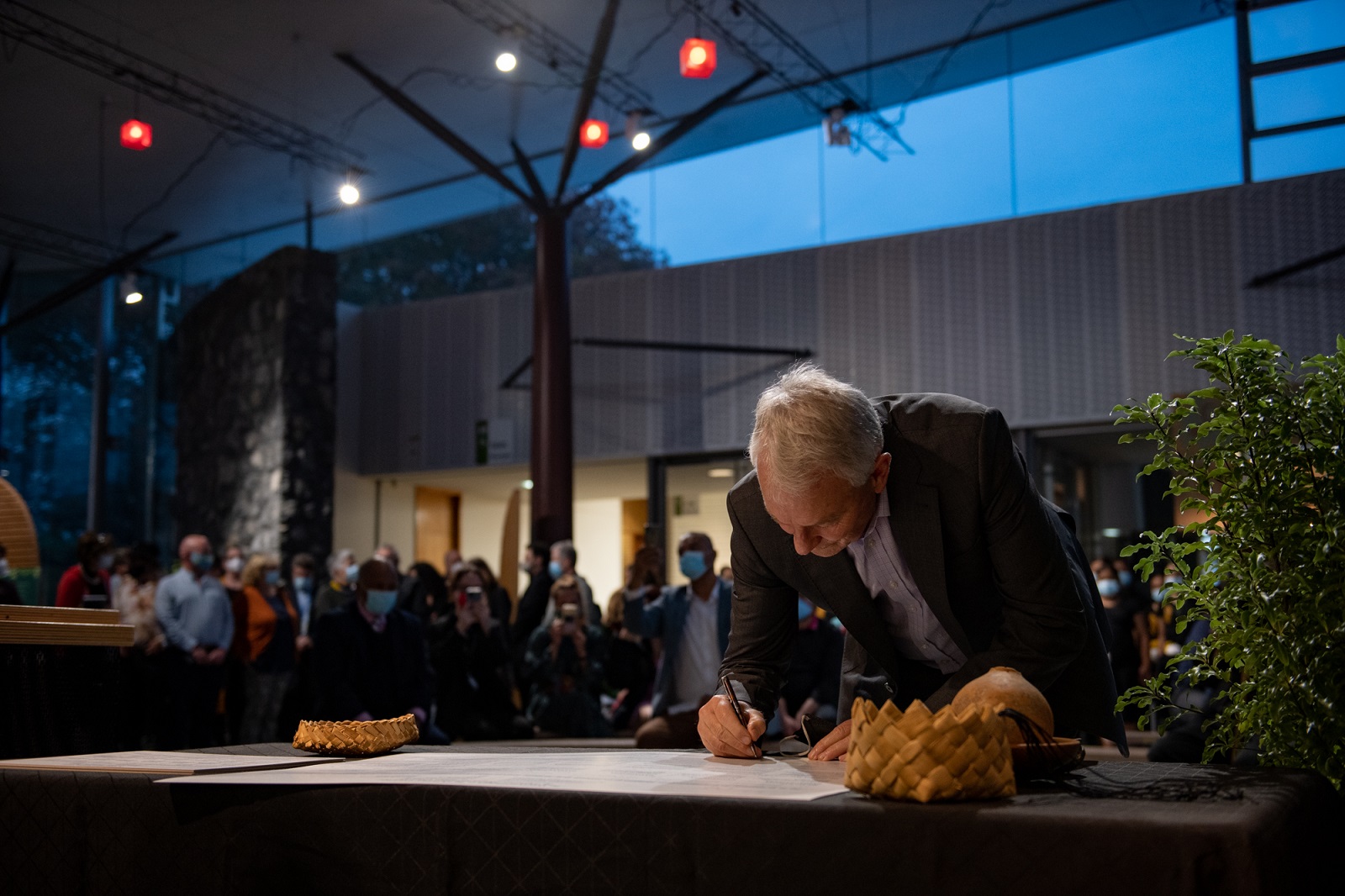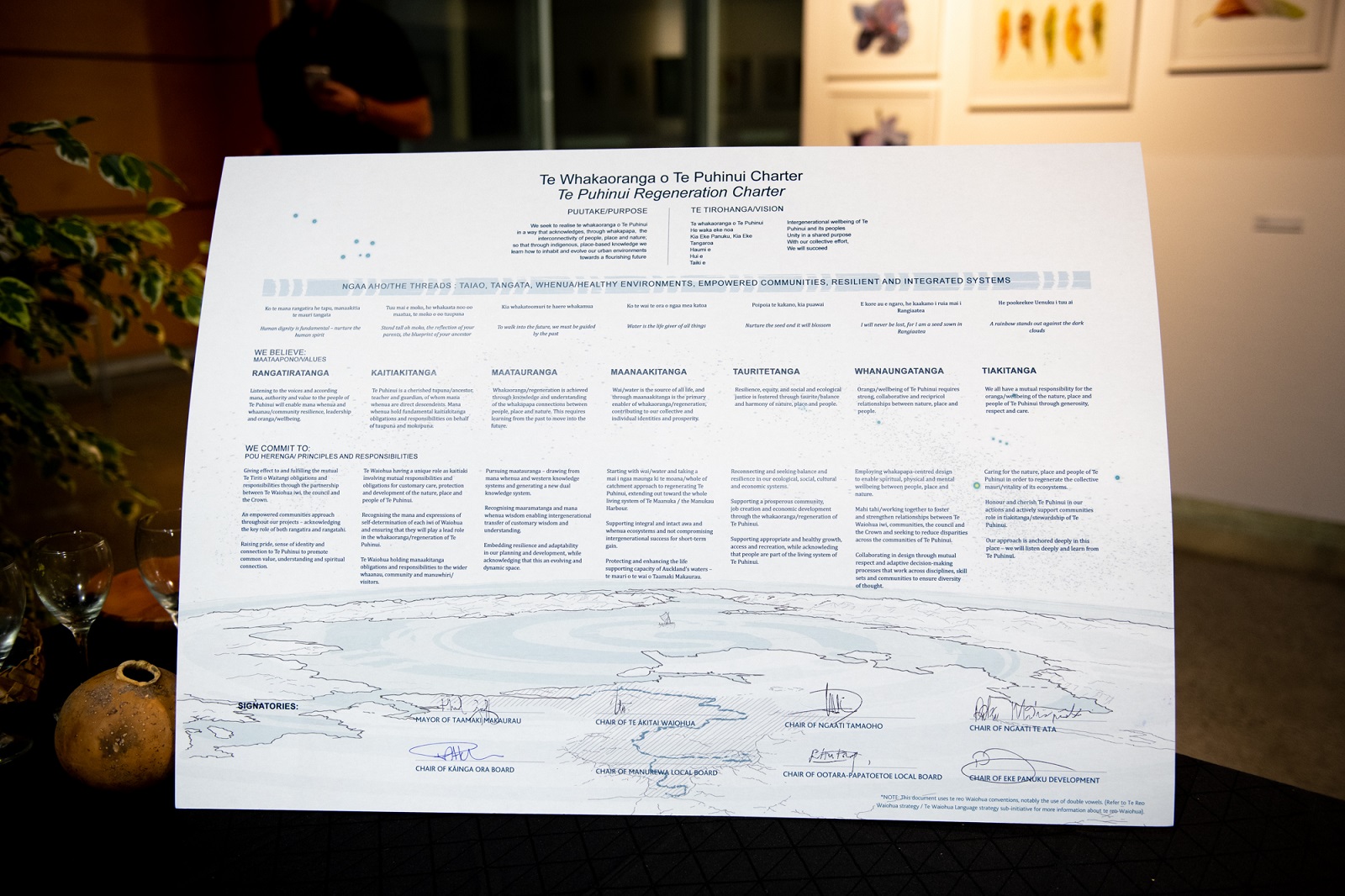Papaki kau ana ngaa tai o Te Maanukanuka o Hoturoa, Paakia ki uta, paakia ki tai, Teretere haere ana ngaa wai maariri o te Puhinui, Te awa koiora me te awa taauru whakapiki ora, Hoki atu raa ki ngaa Matukurua, ko Matukutuureia raaua ko Matukutuururu, Ko ngaa tuupuna maunga tawhito, tuu te ao, tuu te poo, Aro atu te manawa ki a Manukau taangata rau, Araa, te pae haumako me te whenua makuru o Te Waiohua, Huri taiahio ko ngaa uri taakerekere oo Huakaiwaka, Ngaa raukura matahiiapo aana, Tukua mai kia piri, tukua mai kia tata, Tukua mai ki Puhinui, Kia whakaoratia toona tapu, toona mauri me toona mana, Kia eke Panuku, kia eke Tangaroa, Haumi-ee, Hui-ee, Taaiki ee!
The tides of the Manukau Harbour blow gently, Gently blowing on shore and blowing out shore, The tranquil waters of Puhinui Stream flow, And its life giving properties enhance our vitality, Let me return to the ancestral mountains of Maatukutuureia and Matukutuururu, The ancient mountains that stand resilient day and night, As we turn our hearts to Manukau the land of many people, Therein lies the fertile and rich lands of the Waiohua people, The cleansing wind gathers the descendants of Huakaiwaka, His treasured and precious feathers, Let us come together, let us draw near, Let us come closer to Puhinui, So that we may restore its sacredness, its vitality and its prestige, As we invoke the seen and unseen energies to propel us forward, Let us be united, connected and together as one!
Key project partners have come together as founding signatories of Te Whakaoranga o Te Puhinui – Puhinui Regeneration charter, signalling their ongoing support for a new collaborative way of working, led by indigenous knowledge. This will guide future urban renewal projects, community action and investment across the Puhinui catchment.
Te Whakaoranga o Te Puhinui - Puhinui Regeneration is a living strategy that sets out a roadmap for action to restore the environment and communities of Te Puhinui to health. The underpinning principles and aspirational outcomes are encapsulated in a collaborative charter that has been co-authored by the key project partners over the past three years and was signed at a special commemorative ceremony in Manurewa yesterday evening.
Suggested and primarily driven by Te Waiohua Iwi (Ngaati Te Ata Waiohua, Ngaati Tamaoho and Te Ākitai Waiohua), the charter was endorsed by Auckland Council’s Governing Body at its August 2021 meeting for ratification however the project partners were unable to gather to sign it at the time.
This ground-breaking document is the culmination of many years of collaboration among Te Waiohua, the council whānau, Ōtara-Papatoetoe and Manurewa local boards, Kāinga Ora, Te Papa Atawhai (DOC), and local community groups. It enables Te Waiohua iwi to fulfil their role as kaitiaki to this area and is supported by a comprehensive regeneration strategy outlining a range of initiatives and capital works required over the near and far term to enable ‘Te Whakaora’ - the bringing of health to Te Puhinui.
Representatives from Auckland Council, Te Waiohua iwi (Ngaati Tamaoho Waiohua, Ngaati Te Ata and Te Ākitai Waiohua), Kāinga Ora, Eke Panuku Development Auckland, Ōtara-Papatoetoe and Manurewa local boards pledged their commitment by signing the document, with several other key community partners signing a register of support for the charter.
Te Ākitai Waiohua chair Karen Wilson says she is humbled by the opportunity to have support from mana whenua to develop the charter.
“For us this is an important step towards realising our own tino rangatiratanga and being able to protect and look after our places and people and carry out our manaaki and kaitiaki responsibilities which we have been fighting to be able to do for over 200 years.
“It has truly been a collective effort to get to this point. The support from the wider mana whenua roopu and their endorsement of us leading this mahi has allowed the Waiohua iwi to come together as a collective, strengthening those hononga to collaborate on this document.
“I would like to acknowledge all of those involved so far in this kaupapa and those organisations who have been doing what they can for the tuupuna awa. I would also like to acknowledge the founding signatories on their commitment through this charter and urge them to continue to prioritise and value the solutions that exist in maatauranga Maaori,” she says.

Mayor Phil Goff said it was good to see the Puhinui Stream being restored to a clean and beautiful waterway after decades of degradation.
“I played in this stream as a kid but after years of it being a dumping ground for rubbish and suffering from pollution, nobody would wish to play in it today,” he said.
“In common with actions being taken across the city, it’s time to restore ‘te mana o te wai’ to the stream, to give it back its life-giving qualities.
“We want people in our urban areas to enjoy clean and open streams, with the areas around them planted in shrubs and trees and providing play areas for kids, as well as cycling and walking paths.
“It’s great to be entering into a partnership between council, mana whenua, and other stakeholders to work together to restore and manage Te Puhinui as an important natural asset for the people who live around it,” Mayor Goff said.
A direct response to the Manukau Framework Plan, which sets out the approach for how Eke Panuku and its partners will transform Manukau over the next 20 to 25 years, Te Whakaoranga o Te Puhinui – Puhinui Regeneration takes a holistic approach to the whakaoranga of the stream, which includes the health of tangata, whenua and taiao (people, place and nature).

Eke Panuku chair Paul Majurey says, “As the last remaining natural area in this part of the Manukau, and an important link to the cultural and ecological heritage, Eke Panuku is incredibly proud to be leading the collaboration with Te Waiohua to restore the mauri of Te Puhinui as part of our Transform Manukau programme”.
“Four years ago, Te Waiohua challenged us to think bigger than our traditional programme boundaries here. To look at the whole catchment and implement a mai i ngā maunga ki te moana, mountains-to-sea approach.
“This truly embodies the meaning of regeneration and requires innovation and partnership. The next critical stage for this kaupapa is to bring the charter and strategy to life through action and will require many hands. Much work is already planned and underway to regenerate health to this catchment environment and its communities,” he says.


